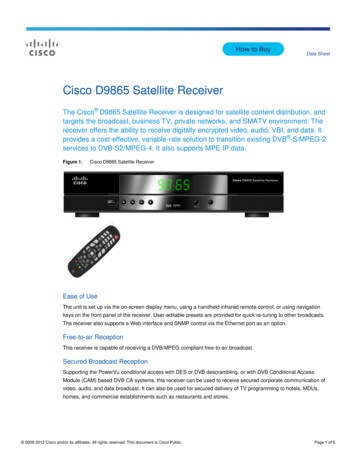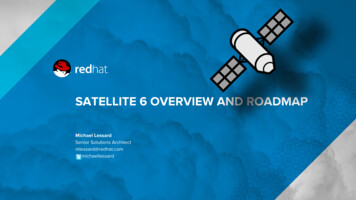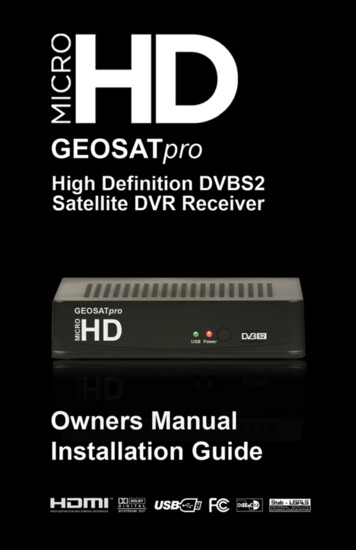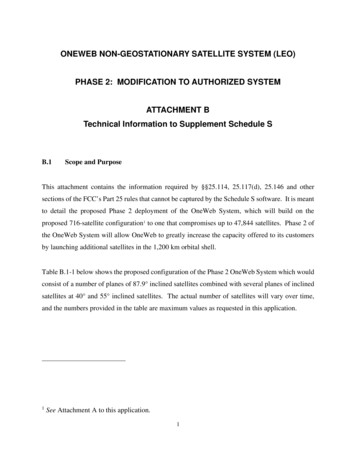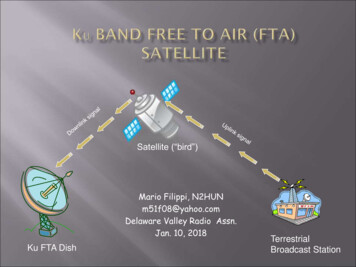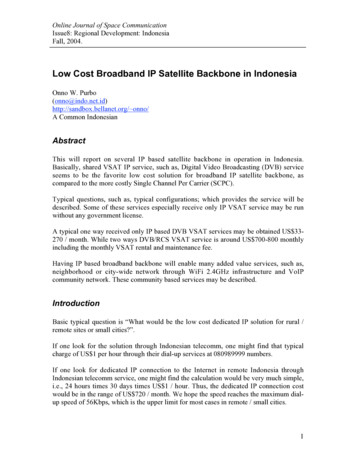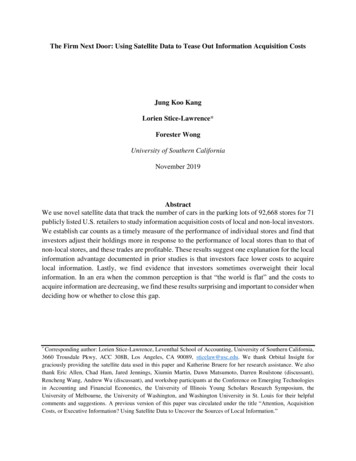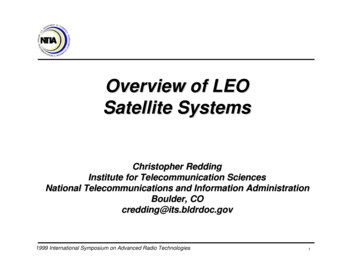
Transcription
Overview of LEOSatellite SystemsChristopher ReddingInstitute for Telecommunication SciencesNational Telecommunications and Information AdministrationBoulder, COcredding@its.bldrdoc.gov1999 International Symposium on Advanced Radio Technologies1
Overview Characteristics of LEO SystemsEmergence of LEO TechnologyClassification of LEOsLEO SystemsIridiumGovernment InvolvementConclusion1999 International Symposium on Advanced Radio Technologies2
Characteristics of LEO Systems “Anytime, Anywhere” Blends cellular and satellite technologies– Satellite– Terrestrial– Gateways 500 - 2000 km orbit– Below Van Allen Belts Fiber-like propagation delay Voice and data capabilities Hand-held multi-mode phones1999 International Symposium on Advanced Radio Technologies3
Emergence of LEO Technology Lower propagation delay in LEO vs GEO– toll quality voice circuits now possible– IP over satellite Use of Ka frequency band vs C and Ku– smaller antennas Advances in satellite technology–––––ACTS, MILSTARinter-satellite links (ISL)on-board processingswitching, routing, store-and-forwardimprovements in satellite manufacturing process1999 International Symposium on Advanced Radio Technologies4
Emergence of LEO Technology Spot beam frequency reuse Lower launch costs– Multiple satellites per launch– New launch sites in China and Russia Need for global wireless services– voice– data Bandwidth demand– data applications Vocoder technology– toll quality voice at 2400 bps1999 International Symposium on Advanced Radio Technologies5
LEO versus GEO Less propagation delay for LEOs More LEOs required for global coverage Single LEO failure will not result in lostcommunication Less exposure to Van Allen Belt radiation Inter-satellite links versus bent-pipe Jitter Ka band– Rain attenuation1999 International Symposium on Advanced Radio Technologies6
LEO Subscriber Growth1999 International Symposium on Advanced Radio Technologies7
Classes of LEOs Little LEOs––––Non-voice servicesOrbcommLEO OneFinal Analysis Big LEOs––––Voice plus limited data servicesIridiumGlobalstarConstellation Communications Broadband LEOs– High-speed data plus voice– Teledesic– SkyBridge1999 International Symposium on Advanced Radio Technologies8
Little LEOsSystemOrbcommLEO OneFinal AnalysisCompanyOrbcomm, Orbital SciencesLEO OneFinal Analysis, GeneralDynamics Info SystemsService Typesmessaging, paging, e-mailmessaging, paging, e-mailmessaging, e-mail, file transferVoice (kbps)---------------Data Rate2.4 kbps uplink4.8 kbps downlink2.4-9.6 kbps uplink24 kbps downlinkTBDOrbit Altitude (km)8259501000No. of Satellites484838No. of Orbit Planes387Earth Stations10207Mobile Uplink148-150 MHz148-150 MHzVHF/UHFMobile Downlink137-138 MHz, 400 MHz137-138 MHz137-138 MHzFeeder Uplink148-150 MHz148-150.5 MHzVHF/UHFFeeder Downlink137-138 MHz, 400 MHz400.15-401 MHzVHF/UHFISLNoNoNoService Date1996200220011999 International Symposium on Advanced Radio Technologies9
Big ionsCompanyMotorolaLoral, Alcatel, Qualcomm Orbital Sciences, BellAtlantic, RaytheonService Typesvoice, data, fax, paging,messagingvoice, data, fax, paging,messagingvoice, data, faxVoice (kbps)2.4adaptive 2.4 / 4.8 / 9.62.4Data (kbps)2.47.228.8Orbit Altitude (km)78014102000Number of Satellites664846Orbit Planes688Earth Stations15 - 20100 - 210TBDBeams / Satellite481624/32Footprint Dia. (km)47005850TBDMobile Uplink (MHz)1616 - 1626.5 (L-band)1610 - 1626.5 (L-band)2483.5 - 2500 (S-band)Mobile Downlink (MHz) 1616 - 1626.5 (L-band)2483.5 - 2500.0 (S-band) 1610 - 1626.5 (L-band)Feeder Uplink (GHz)27.5 - 30.0 (Ka-band)5.091 - 5.250 (C-band)5.091 - 5.250 (C-band)Feeder Downlink (GHz) 18.8 - 20.2 (Ka-band)6.875 - 7.055 (C-band)6.924 - 7.075 (C-band)ISLYes (4)NoNoService Date1998200020011999 International Symposium on Advanced Radio Technologies10
Broadband LEOsSystemSkyBridgeTeledesicCompanyAlcatel, LoralMotorola, Boeing, MatraMarconi, Gates, McCawService Typesinternet access, voice, data,video, videoconferencinginternet access, voice, data,video, videoconferencingVoice (kbps)TBD16Data (kbps)2,000 uplink20,000 downlink2,000 uplink64,000 downlinkOrbit Altitude (km)14691375Number of Satellites80288Number of Orbit Planes212Earth Stations200TBDBeams / Satellite 5064Footprint Diameter(km)30001412Feeder Uplink (MHz)Ku-band28,600 - 29,100 (Ka-band)Feeder Downlink (MHz)Ku-band18,800 - 19,300 (Ka-band)ISLNoYes (8)Service Date200120041999 International Symposium on Advanced Radio Technologies11
LEO Orbital Altitudes1999 International Symposium on Advanced Radio Technologies12
Orbcomm Operational since 1996 Trailer tracking services for trucking fleets Two-way messaging technology beingmarketed to US government and military GPS hand-held satellite communicatorintegrates Orbcomm technology forworldwide messaging Internet capabilities– Planned IP messaging gateway for HTTP, XMLand UDP messaging functions– SMTP/POP3 and X.400 global wireless e-mail1999 International Symposium on Advanced Radio Technologies13
Orbcomm Constellation1999 International Symposium on Advanced Radio Technologies14
LEO One Provides near real-time store-and-forwardmessaging–––––tracking and fleet managementmonitoring and remote controltwo-way messagingemergency servicestransaction processing Finished development of satellite antennasystem and gateway station1999 International Symposium on Advanced Radio Technologies15
Final Analysis 36 satellites in 6 orbital planes at 51E– 2 satellites in 83E plane Three ground stations completed Terminals– Remote Terminal– Messaging Terminal– File Transfer Terminal Services offered– real-time– near real-time– store and forward1999 International Symposium on Advanced Radio Technologies16
Globalstar 36 Globalstar satellites in space as of August17 launch Fleet of 48 will be in orbit by December– 4 per launch Commercial service to start October 10 Employs bent-pipe vs ISL– proven technology Coverage concentrated between /- 70E Phone manufacturers– Ericsson, Qualcomm and Telital1999 International Symposium on Advanced Radio Technologies17
Globalstar Constellation1999 International Symposium on Advanced Radio Technologies18
Constellation Communications Data oriented Initial phase will have single equatorial orbit of11 satellites– Coverage between /- 23 E– Service to begin in 2001 Additional 35 will be deployed– Five per orbit in seven circular inclined orbits– Global service in 20031999 International Symposium on Advanced Radio Technologies19
Teledesic Combines efforts with Celestri (1998)– Motorola becomes prime Teledesic partner “Internet-in-the-sky” Portable vs mobile– 45 cm antenna– directional Lockheed Martin launch provider Motorola - constellation's system provider1999 International Symposium on Advanced Radio Technologies20
Teledesic Constellation1999 International Symposium on Advanced Radio Technologies21
SkyBridge Protects GEO systems in the Ku-band throughfrequency re-use concept Proven technologies reduce cost and overallrisks of system–––––gateways use ATM-based interfacessupports Internet protocols"bent-pipe" systemterrestrial-based switchingKu-band frequency lower hardware costs due to mature technology less signal attenuation due to rain than Ka frequencies1999 International Symposium on Advanced Radio Technologies22
Iridium Voice network operational since November 98 On-board processing and ISLs Separate voice and data channels––––2400 bps voice: low latency2400 bps data: error-free deliverypacket switcheddata channel expected in 99 Types of connections– Iridium to/from PSTN– Iridium to Iridium1999 International Symposium on Advanced Radio Technologies23
Iridium Constellation1999 International Symposium on Advanced Radio Technologies24
Iridium System Overview1999 International Symposium on Advanced Radio Technologies25
Iridium Call Scenario1999 International Symposium on Advanced Radio Technologies26
Iridium in the News Iridium gets US Military as First Big Customer(1/26/98) The World's First Global Satellite Telephone andPaging Company Starts Service (11/1/98) Iridium CEO opts to leave (6/14/99) Iridium cuts staff, stock suffers (6/14/99) Iridium cuts prices to boost subscriber base(6/21/99) Motorola calls for help with Iridium (7/14/99) Iridium Files Chapter 11 Bankruptcy (8/13/99)1999 International Symposium on Advanced Radio Technologies27
Government Involvement Enhanced Mobile Satellite Service (EMSS)––––Iridium network4 DISA contracts ( 300M)Secure calling via DoD gatewayEnd-to-end security via secure phones Future Narrow Band Digital Terminal (FNBDT)– Government funded / Industry supported– Working Group formed to develop secure mode ofoperation between STU-III and GSM, CDMA andLEO satellite systems such as Iridium and Globalstar1999 International Symposium on Advanced Radio Technologies28
Conclusion LEO satellites in period of great interest Latency eases voice and IP applications ISL vs bent-pipe Broadband LEOs will provide last milebroadband connectivity gap Iridium effects on other LEOs Seamless global communications now a reality1999 International Symposium on Advanced Radio Technologies29
Separate voice and data channels – 2400 bps voice: low latency – 2400 bps data: error-free delivery – packet switched – data channel expected in 99 Types of connections – Iridium to/from PSTN – Iridium to Iridium. 1999
